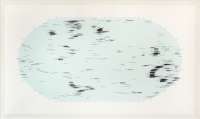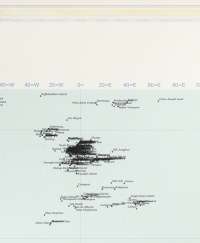Map of Incomplete Listing of Uninhabited Islands of the World, April 2009, 2009 Archival digital print and watercolor on watercolor paper. 30 x 49-3/4 inches
Individually researched, specifically uninhabited islands are charted on a map by coordinate locations and names only, which overlap one another creating illegible masses that cluster to expose the omitted continents. This, an ongoing project and one that is not possible to complete, is an attempt to create an optimistic document, a ‘hopeful document for all’ that suggests that there are still places to go.
At the beginning of 2009 I began the project to create a Map of a Listing of the Uninhabited Islands of the World. My idea was to accurately plot all of the uninhabited islands on a blank map, with all major landmasses removed. Each uninhabited island is represented simply by a dot and its name. These names frequently overlap one another, causing illegible blurring of text, nonetheless serving to indicate that there are untapped territories in that region. It was my intention to create a hopeful document for all – that there are still places for us to go, whilst also drawing attention to the fact that islands are actually appearing and disappearing regularly. The idea came about due to a broader interest in the underestimated correlation between geological time and human, experiential time. I began the research as an obviously pseudo-scientific, but very romantic, effort. Seemingly dreamy and optimistic on one level, I believe that once we move past the notion of the idealized desert island we get to the idea the idea of limit, the finite nature of 'place'. We begin to think of islands as used as prisons, as places to be banished to, or unforgiving in terms of harshness, as much as the positive associations. It sharpens our sense of place and we might appreciate and respect the ground we are standing on a little more.
At that time I spent a period of three months researching islands individually, checking for zero population, and recording and plotting their geographical coordinates. I confirmed with the Harvard Geospatial Library that such a document does not already exist. Early in the preliminary research stage I realized that this piece would become a ‘map of incomplete listing of uninhabited Islands of the world’. I quickly discovered that there are approximately 130,000 distinct landmasses in the world, many of which are, of course, inhabited. I included almost 3400 uninhabited islands on my map. It is my ambition to compile a complete document of all of those that are uninhabited. Due to the flux caused by volcanic activity, this task is impossible by nature.
The information being offered sits between science and art. The piece is not as 'serious' of a document as it might sound, and starring Kaffeklubben Island (The Coffee Club Island), Disappointment Island, etc., in some ways it charts a broad human spirit.
(Note: The images included are of the first incomplete iteration of my research, printed out and dated April 2009 to chart my progress at that point.)
Map of Incomplete Listing of Uninhabited Islands of the World, April 2009, 2009 Archival digital print and watercolor on watercolor paper. 30 x 49-3/4 inches
Individually researched, specifically uninhabited islands are charted on a map by coordinate locations and names only, which overlap one another creating illegible masses that cluster to expose the omitted continents. This, an ongoing project and one that is not possible to complete, is an attempt to create an optimistic document, a ‘hopeful document for all’ that suggests that there are still places to go.
At the beginning of 2009 I began the project to create a Map of a Listing of the Uninhabited Islands of the World. My idea was to accurately plot all of the uninhabited islands on a blank map, with all major landmasses removed. Each uninhabited island is represented simply by a dot and its name. These names frequently overlap one another, causing illegible blurring of text, nonetheless serving to indicate that there are untapped territories in that region. It was my intention to create a hopeful document for all – that there are still places for us to go, whilst also drawing attention to the fact that islands are actually appearing and disappearing regularly. The idea came about due to a broader interest in the underestimated correlation between geological time and human, experiential time. I began the research as an obviously pseudo-scientific, but very romantic, effort. Seemingly dreamy and optimistic on one level, I believe that once we move past the notion of the idealized desert island we get to the idea the idea of limit, the finite nature of 'place'. We begin to think of islands as used as prisons, as places to be banished to, or unforgiving in terms of harshness, as much as the positive associations. It sharpens our sense of place and we might appreciate and respect the ground we are standing on a little more.
At that time I spent a period of three months researching islands individually, checking for zero population, and recording and plotting their geographical coordinates. I confirmed with the Harvard Geospatial Library that such a document does not already exist. Early in the preliminary research stage I realized that this piece would become a ‘map of incomplete listing of uninhabited Islands of the world’. I quickly discovered that there are approximately 130,000 distinct landmasses in the world, many of which are, of course, inhabited. I included almost 3400 uninhabited islands on my map. It is my ambition to compile a complete document of all of those that are uninhabited. Due to the flux caused by volcanic activity, this task is impossible by nature.
The information being offered sits between science and art. The piece is not as 'serious' of a document as it might sound, and starring Kaffeklubben Island (The Coffee Club Island), Disappointment Island, etc., in some ways it charts a broad human spirit.
(Note: The images included are of the first incomplete iteration of my research, printed out and dated April 2009 to chart my progress at that point.)

